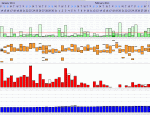I think that's impressive improvising.
Your post also suggests you're wondering whether the improvised humidifier circuit might introduce problems. Does the extra hose length drop pressure, for instance? Does the added circuit volume and shape somehow buffer waveshape signal used by the S9 algorithm? Do surface irregularities or leak points somehow introduce false waveshape irregularities, skewing those same flow signals used by the algorithm?
Well, you probably don't have the same deep-pocket lab-testing budget APAP manufacturers have. But you can at least run a few practical verification tests if you would like. I think I would probably run some basic verification tests, perhaps something along these lines:
1) set a fixed pressure at previous 95% APAP pressure, and measure mask end of circuit using a manometer
2) set fixed pressure(s) at APAP range low and/or mid level values, and again measure far end using a manometer
3) review nightly S9 ResScan data to look for excessive leaks
4) review nightly S9 ResScan data to heuristically analyze detailed flow waveshape for obvious anomalies
If you don't already have a manometer and would like to build one, there are plenty of searchable how-to threads. Also, see Uncle_Bob's signature line below for a comment about hose length as well as a download link to Resmed's free ResScan software:
viewtopic.php?f=1&t=77498&p=706061#p706061
Good luck with your S9 trial!













